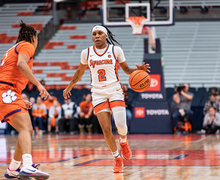Recruiting young presents slippery slope
The recent trend of Division I coaches recruiting younger and younger athletes — particularly in men’s lacrosse — must be limited. And coaches and athletic departments must be mindful when recruiting young student-athletes whose futures are uncertain.
Currently the NCAA has strict regulations that limit when student-athletes can sign letters of intent during their senior years of high school. But there are no limitations on when a student can make a non-binding — yet widely recognized — verbal commitment. There should be.
Whether that regulation comes from the NCAA or conferences themselves, Division I athletic teams must be prevented from recruiting student-athletes who are still in middle school. While the number of athletes being recruited before high school is infrequent, there has been a recent trend of recruiting high school freshmen, and a few eighth grade recruits. The trend toward younger recruits needs to be curbed.
The reason recruits are getting younger is because Division I lacrosse programs are in competition over the best athletes. With some major programs getting to athletes sooner, it pressures other programs to follow suit. And because every team receives only 12.6 scholarships — considering there are more than 40 players on the team — athletes could likely feel that when an offer comes their way, they have to jump on it.
Middle school athletes cannot be expected to make a decision that will shape the rest of their lives. While the verbal commitment the athletes make in middle school is non-binding, it is influential. Students at this age are children — 13 and 14 years old. They may be outstanding athletes but they are not fully mature. It is possible that the students are being pressured to make these decisions.
Coaches who enter into these agreements with young athletes should also be cautious. Having so much time between the commitment and the arrival at college leaves plenty of uncertainty. Students may not develop at the athletic or academic pace expected.
The coaches and family members guiding the student during the decision process should also clearly detail what is on the line. Students should understand that these commitments don’t guarantee a spot on the team; the students must uphold the teams’ academic and conduct standards to keep the agreement.
Recruiting increasingly younger players is a slippery slope. It needs to be closely monitored for the best interest of the student-athletes and the Division I athletic programs.
Published on March 25, 2015 at 12:05 am




